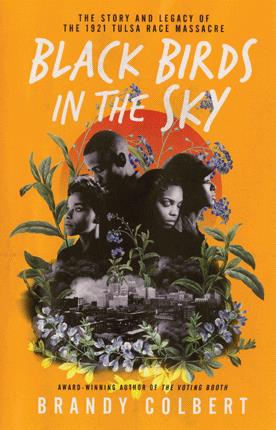| Black birds in the sky : the story and legacy of the 1921 Tulsa Race Massacre Author: Colbert, Brandy | ||
| Price: $24.48 | ||
Summary:
Tells the story of one of the most deadly and destructive acts of racial violence in American history: the 1921 destruction of the Greenwood district of Tulsa, Oklahoma, commonly known as the Tulsa Race Massacre.
| Accelerated Reader Information: Interest Level: UG Reading Level: 9.20 Points: 9.0 Quiz: 514515 |
Reviews:
Kirkus Reviews (+) (08/01/21)
School Library Journal (+) (00/11/21)
Booklist (+) (08/01/21)
The Hornbook (00/09/21)
Full Text Reviews:
Booklist - 08/01/2021 *Starred Review* In recent years, the 1921 Tulsa Race Massacre, which resulted in the destruction of Black Wall Street and the thriving Greenwood District in Tulsa, has become a more widely covered and discussed point of U.S. history. This title offers a timely account for young adult readers. While it could have been written as a single, tragic event in an otherwise progressively trending nation, Colbert takes time and care to situate and contextualize the massacre as part of the longstanding history and legacy of racism in America. Beginning with Oklahoma’s journey to statehood, moving through Reconstruction, the onset of Jim Crow, and the establishment of Black Wall Street, this book intricately places nuanced quotes and stories of individuals alongside the wider context of a blatantly racist society. Together with the inclusion of primary documents, such as photographs, newspaper headlines and articles, readers are left with a vivid picture that will surely resonate with current events. Colbert writes confidently about the truth of American history that has been long omitted from textbooks and conversations, and there is no mistaking her intention as she presents a case for acknowledging lingering racist ideas, sentiments, and assumptions and for holding ourselves accountable to overturning the harm that racism has caused. Necessary reading for any student of history or for anyone trying to understand our present. - Copyright 2021 Booklist.
School Library Journal - 11/01/2021 Gr 7 Up—After generations of erasure and a concerted effort to cover up history, the story of the 1921 Tulsa Race Massacre is finally being told in a modern historical context. Following the alleged assault of a white woman by a Black man in an elevator, the thriving Black community of Greenwood, Oklahoma (also known as Black Wall Street), was heaved into violence and destruction when a white mob descended on the town to seek revenge. Colbert recounts the event in detail, piecing together accounts from survivors and news stories, though many newspaper articles were not recovered in full. Colbert dives into the events directly preceding the massacre and gives ample context through the founding of Tulsa, mounting racial tensions in the region and elsewhere, the aftermath of Reconstruction, and the forcible removal of the Muscogee (Creek) people from the land. Her foreword frames her own upbringing in a majority white community and flows into the many historical and cultural factors that led up to the 1921 massacre, emphasizing the point that no one act of violence against a Black community can be viewed as an isolated event. Clear straightforward text, photos, and well-organized storytelling makes this an essential read for teens and adults alike. VERDICT A must-have first purchase for all libraries; this text invites readers to engage with a difficult history that's essential in our understanding of today's world.—Allison Staley, Lake Oswego P.L., OR - Copyright 2021 Publishers Weekly, Library Journal and/or School Library Journal used with permission.




